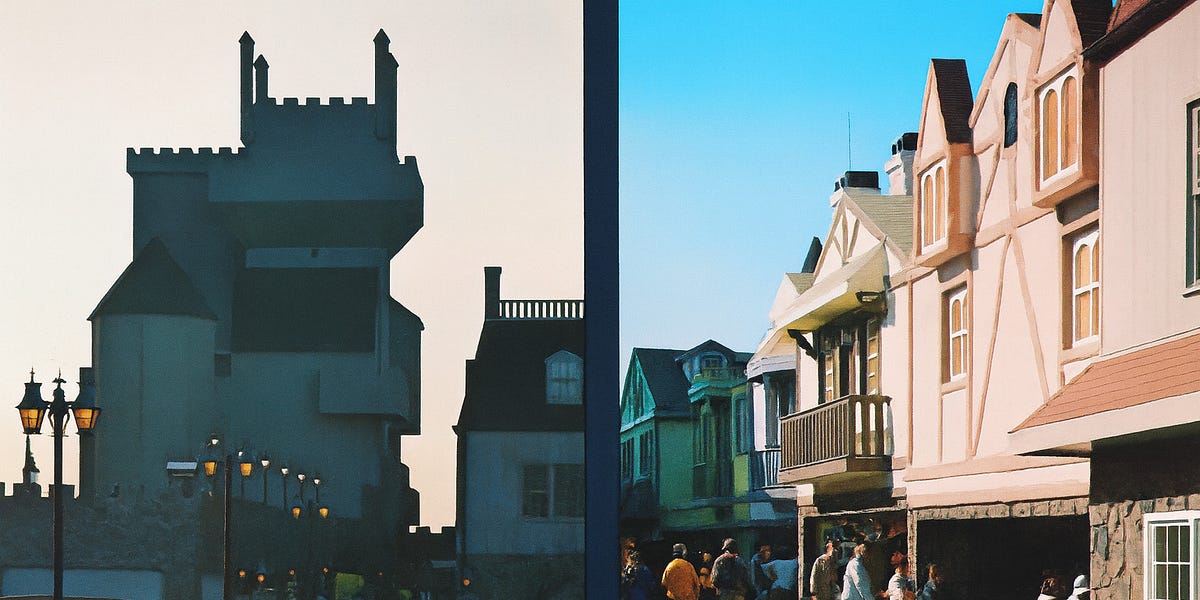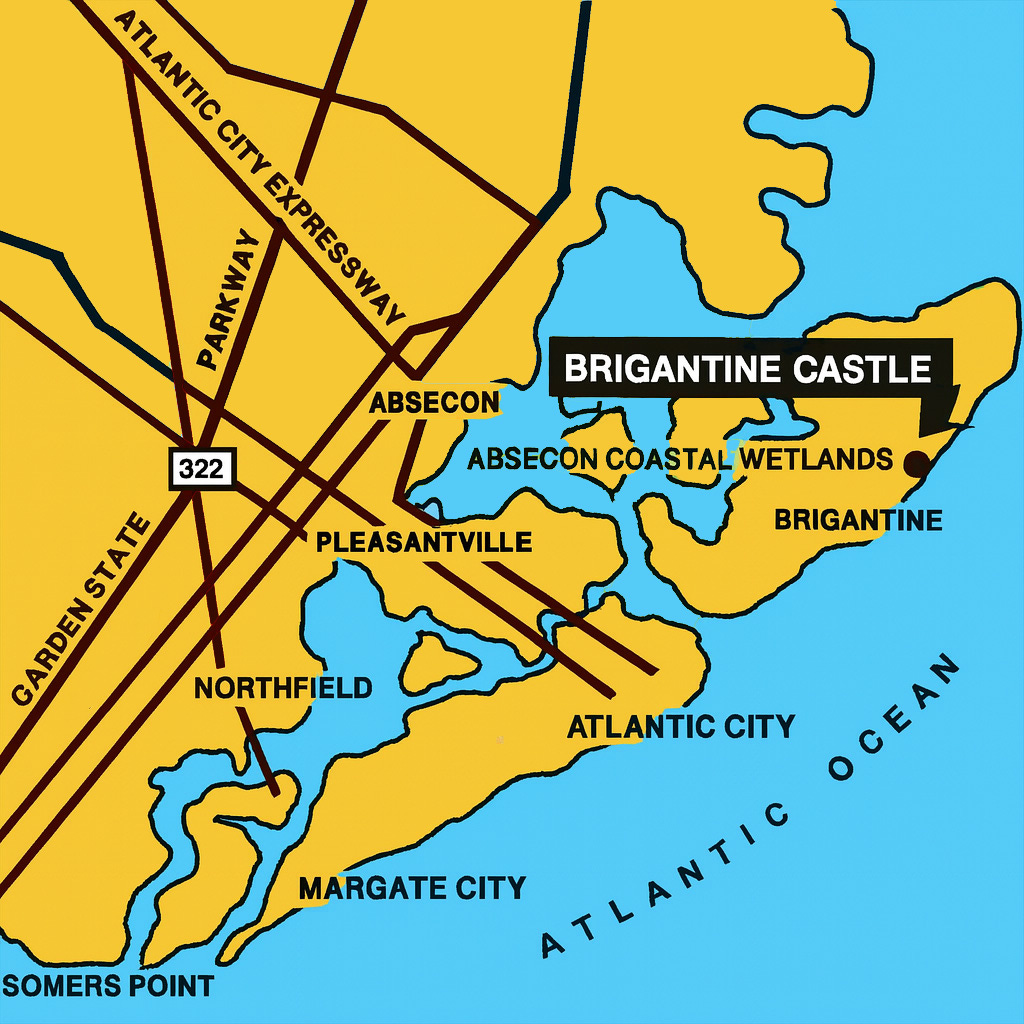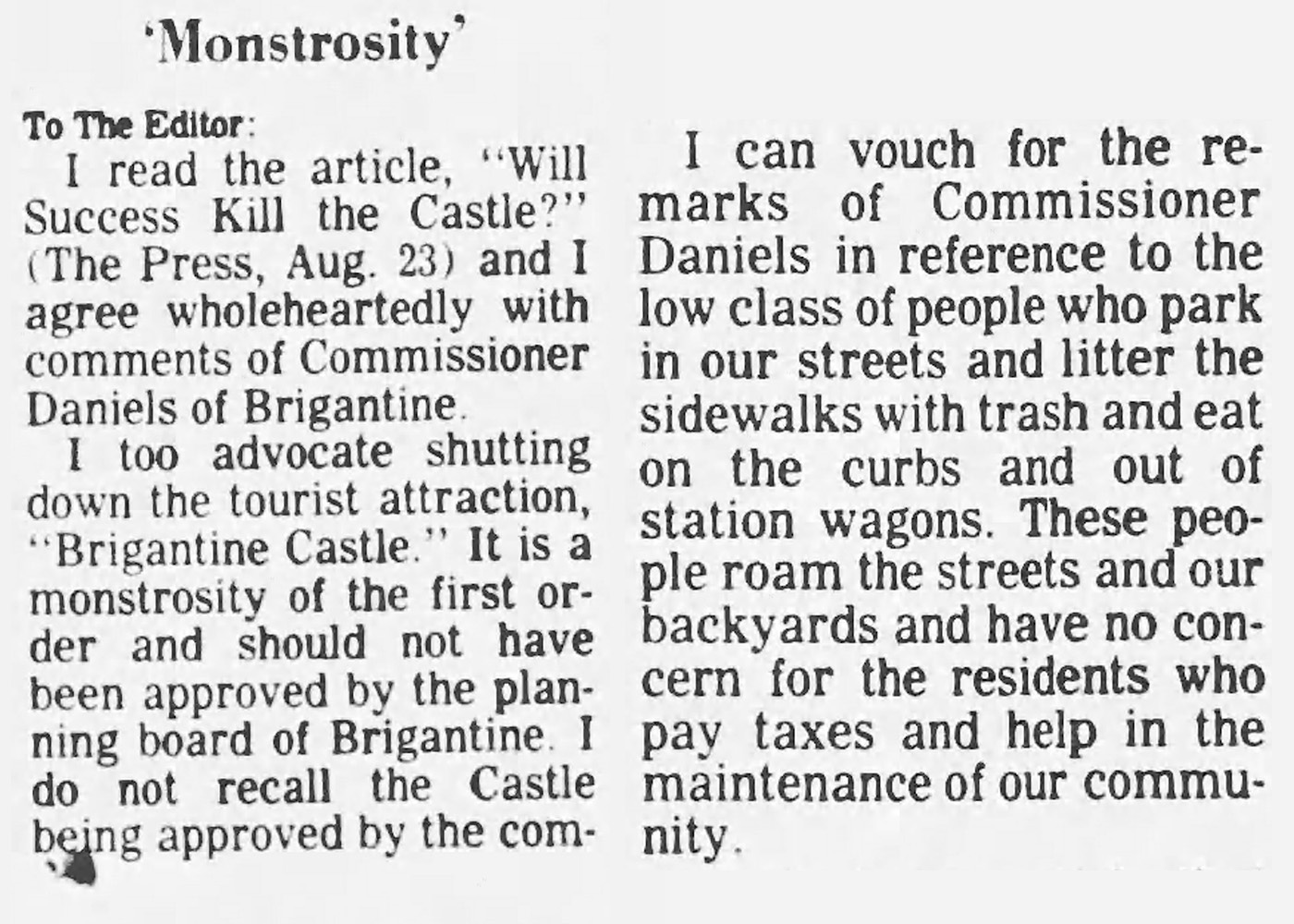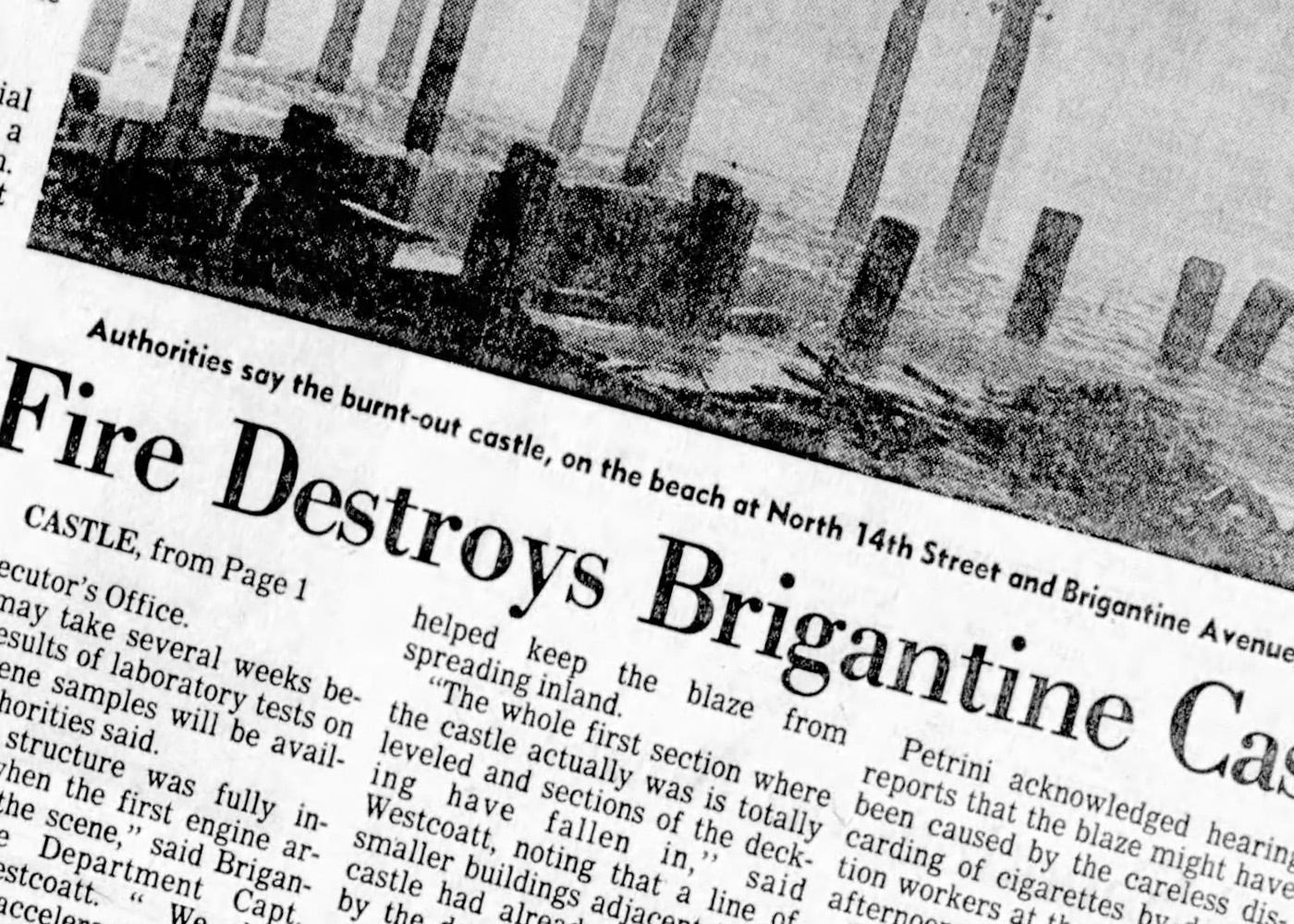
As a kid, seeing the Brigantine Castle commercials on TV was both scary and exciting. The ads showed the dark towering building rising out of the Jersey surf, shadowy figures moving through fog, and actors jumping out at screaming visitors. They made it look larger than life, like a horror movie set you could actually walk through. When my family finally took a trip to the area, the idea of seeing it in person had been playing in my head for at least a year.
Driving over the bridge into Brigantine (which is an island), I swore that the castle came into view before anything else. It looked even taller than it did on television, perched over the ocean on its pier like something that didn’t quite belong in a beach town. We went straight to it. Standing in line, hearing the waves under the boards and the muffled shrieks from inside, only added to the feeling that this was a big event. I was still finding out what horror and being scared on purpose was all about, so this felt like a big step towards something that older kids did. So, while I was nervous, I went in with my sisters.
That first visit was thrilling and terrifying, but that’s not really what I think about all these years later. It was the oddness of the place. A fake gloomy castle built over the ocean and meant to be enjoyed in the warm New Jersey summer sun. My imagination was on fire. It made me wonder how it ended up there. I assumed it was something old, but the truth isn’t very frightening. It all started a few decades earlier.
Seahorse Pier stood on the north end of Brigantine before the construction of Brigantine Castle. It was known as a fishing pier and beer joint and served as a modest local gathering spot. Over time, storms damaged the structure and upkeep lagged, leaving it in poor condition by the early 1970s. The pier was deteriorating and in need of costly repairs, which made it less suited to the growing emphasis on larger, more modern attractions in nearby shore towns.
By the mid 1970s, Brigantine officials were looking for ways to bring more visitors to the island, and the pier’s decline presented both a problem and an opportunity. Enter Carmen Ricci, a businessman with a flair for theatrical attractions. Rather than tear the structure down, Ricci proposed building something entirely new on top of it, something that would catch attention from miles away. His plan was to turn the worn pier into the foundation for a towering haunted castle with turrets, winding passages, and costumed performers. It was an ambitious idea that promised to turn a fading local fixture into a major draw for summer crowds.
Construction began early in 1976 on the site of the old Seahorse Pier, and crews worked through winter and spring to get it ready in time for the summer season. On Memorial Day weekend of 1976, the castle opened its doors to the public for the first time. A giant medieval style structure with towers rising on the pier was visible from across the water as drivers crossed the bridge into Brigantine. For a quiet shore town, it was unlike anything else.
The castle’s haunted walk-through became its main attraction. Guests entered through a darkened, castle-themed façade and made their way through twisting hallways, dimly lit rooms, and surprise encounters with live actors. It was theatrical and immersive, closer to a staged production than a carnival funhouse. Alongside the haunted attraction, there were arcades, gift shops, food stands, and fishing at the far end of the pier, making it a full destination rather than a single ride.
The opening drew large crowds and plenty of press attention. Television ads had already built anticipation across the Philadelphia and New York markets, and curious families arrived by the busload. For Brigantine, which had long been overshadowed by Atlantic City, the castle was a sudden landmark. Its first season was a success, and it quickly became part of summer trips for both locals and vacationers.
During its best years, the castle was well run, with long summer lines and busloads of visitors from nearby cities. From what I read in online groups, many of the people working inside were locals, which gave the place a grounded, familiar feel. The pier became a gathering spot for people who weren’t even going through the haunted walk. Some came to fish or get food, others to meet friends and watch the crowds. Of course not everyone in Brigantine were happy with the Castle.
Some in the town didn’t appreciate the influx of tourists, especially because they didn’t feel like they were included in the decision-making around its approval and construction. The complaints are valid and easy to understand. I grew up in a town that eventually added multiple malls and the number of cars randomly driving through our neighborhoods, lost or trying to find a back-way into a shopping center caused constant headaches for locals. Much like with our malls though, Brigantine Castle had already been built and was attracting crowds that didn’t really have any incite into local opinion. Here are some highlights from a letter written to the local paper in the summer of 1977.
Ricci made regular updates to keep the experience fresh. Rooms were changed between seasons, effects were added, and performers developed routines that kept people coming back. For a few years, the castle held attention well beyond its opening excitement.
The castle’s strong run lasted for roughly five to six seasons, from its opening in 1976 through the early 1980s. By 1982, signs of trouble had started to show. A winter storm that year caused real damage to the pier structure, and the cost of repairs was high. At the same time, nearby Atlantic City’s casino boom was changing how people spent their time and money. Visitors who once came for family attractions were being pulled toward the casinos, and Brigantine began to see fewer day-trippers.
Large scale attractions elsewhere in the state were also drawing the kinds of crowds that once might have visited Brigantine. Great Adventure, which opened in 1974, had quickly grown into one of the region’s biggest amusement parks, offering full days of rides and shows that made smaller seaside attractions seem modest by comparison. Up the coast, the Haunted Mansion at Long Branch (also from Ricci) opened in 1978 and became a major draw of its own. It offered elaborate effects and a purpose-built structure that didn’t face the same maintenance challenges as Brigantine’s pier. Both of these destinations competed directly for visitors’ time and money, raising the bar for what people expected from haunted attractions in New Jersey.
By the mid 1980s, Brigantine Castle was struggling to keep up with rising costs and new safety standards. The structure sat on an aging pier, and years of storms and salt exposure had taken a toll. Maintenance became expensive just as attendance began to level off. A tragic 1984 Six Flags fire led to stricter regulations for haunted attractions, which meant costly upgrades would have been required to keep operating. Insurance rates climbed, and engineers warned that major repairs were needed to keep the pier safe. Faced with mounting expenses and shrinking revenue, the owners chose not to open for the 1985 season. A once burgeoning landmark stood empty, marking the end of its run.
After it closed in 1985, Brigantine Castle sat vacant for more than two years. It remained intact but deteriorated without upkeep. Storms continued to wear away at the pier, and sections of the boardwalk and façade showed visible damage. Efforts to find a buyer or a new use for the property didn’t go anywhere. The cost of bringing it up to new safety codes and repairing the pier was too high to make a relaunch realistic.
Demolition had started by late 1987, but before it could be completed a fire broke out on the night of September 25, 1987, and destroyed what was left of the castle and much of the pier. Two men were later charged with arson. After the fire, the remains were cleared away, and only pilings were left visible along the shoreline. The site was never rebuilt, and the castle’s disappearance marked the end of that era for Brigantine.
To this day, nothing stands where Brigantine Castle once towered over the water. The site at 14th Street North and Brigantine Avenue is now open beachfront, with only a few pilings sometimes visible at low tide. What was once a busy summer destination has blended back into the shoreline. Locals still point out the spot to visitors, but there are no signs or structures left to suggest the castle was ever there.
For a brief period, a small shore town had a towering, theatrical attraction that felt bigger than its surroundings. It arrived during the golden age of local attractions, when independently run piers, haunted houses, and arcades still thrived along the coast. Television ads reached wide audiences, and one creative idea could draw crowds without competing against corporate theme parks. The castle fit that moment perfectly, combining local ambition with smart promotion. It created jobs, gave families a shared experience, and turned a fading pier into a landmark. Even though it’s gone, it represents a time when places like this shaped summer memories in ways that large chains rarely could.
Trending Products





![NOW Country Classics: 90âs Dance Party[Lemon & Spring Green 2 LP]](https://m.media-amazon.com/images/I/61hVquUofcL._SL500_._SS300_.jpg)





